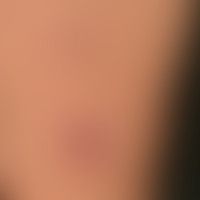Image diagnoses for "Leg/Foot"
395 results with 1158 images
Results forLeg/Foot

Necrobiosis lipoidica L92.1
Necrobiosis lipoidica: Sharply defined, confluent marginal, reddish-brownish, centrally faded, atrophic plaques, increase in consistency in the marginal area.

Necrobiosis lipoidica L92.1
Necrobiosis lipoidica: Medal-shaped plaques with pronounced central atrophy and bizarre translucent vascular structures.

Nevus melanocytic congenital D22.-
Congenital melanocytic nevus. brown, soft, papillomatous plaque sharply demarcated from the surrounding normal skin. no change in colour or shape has been detected so far apart from the "physiological" size growth.

Acroangiodermatitis I87.2
Acroangiodermatitis. detail from the above figure. 0.2-0.4 cm large, initially isolated, then aggregated, deep red to reddish-livid papules develop from the smallest red (haemorrhagic) spots with a smooth surface, which finally confluent to form large plaques.

Spindle cell tumor, pigmented D22.L
Pigmented spindle cell tumor, nevus reed: dark brown to black pigmented plaque, preferably located on the lower leg. The lesion is usually excised under the suspected diagnosis of melanoma. Illustration from the collection of Dr. Michael Hambardzumyan.

Vasculitis leukocytoclastic (non-iga-associated) D69.0; M31.0
Vasculitis, leukocytoclastic (non-IgA-associated). multiple, acute, symmetric, since 2 weeks existing, localized on both lower legs, irregularly distributed, 0.1-0.2 cm large, sharply defined, symptomless, hemorrhagic spots and blisters as well as beginning incrustations.

Prurigo simplex subacuta L28.2
Prurigo simplex subacuata: typical distribution pattern of the interval-like itching, scratched, inflammatory papules and plaques.

Melanoma cutaneous C43.-
Melanoma malignes: multiple cutaneous melanoma metastases in pre-operated nodular melanoma of the lower leg.

Lymphedema secondary I89.0, 197.2
lymphedema secondary: diffuse, uniform swelling of the left lower extremity. if the patient stands for a longer period of time, the swelling increases significantly. condition after pelvic lymphadenectomy.

Larva migrans B76.9
Larva migrans. linear plaque, subepidermally situated, tortuous, constantly itching gait on the right hollow foot. conspicuously in the area of the gait structures described blister formation.

Sarcoidosis of the skin D86.3
Sarcoidosis, subcutaneous nodular form:known pulmonary sarcoidosis; skin findings: subcutaneously and cutaneously located nodules and plates which can be easily distinguished from the surrounding area and which slide on the support.

Squamous cell carcinoma of the skin C44.-
squamous cell carcinoma of the skin: advanced ulcerated carcinoma. previously misinterpreted as a venous ulcer. the carcinoma is palpated as a very firm, little pain-sensitive (!) node, which is hardly movable on its base. a sentinel lymph node biopsy proved negative (no tumor infestation).

Hyperpigmentation postinflammatory L81.0

Melanoma amelanotic C43.L
melanoma malignes amelanotic: since early childhood a pigment mark is known at this site. continuous growth for several years. for half a year extensive ulceration of the node. no significant symptoms.










